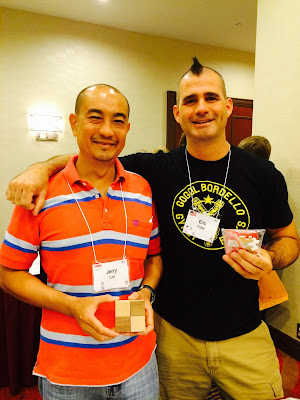My copy is made of MDF (medium density fibre) board, very hard, like wood but at a fraction of the cost, to keep the cost of the puzzle affordable. Although it may not crafted from exotic hardwoods, nonetheless construction, fit and finish is very good. For a puzzle like the 4M, the material chosen works well and the puzzle functions as intended.
If you have played with any of Hiro's puzzles which include the award winning "Odd Puzzle" and the "Jam" series of puzzles, you will know there is always a neat trick involved and its not that simple as it appears.
Dimension-wise, you will discover that trying to put the pieces straight in wouldn't work and slanting all the pieces in randomly won't either. As mentioned, there is a technique of packing the pieces and the solution is what puzzlers would term "elegant". Once all the pieces go in as intended, the lid closes nicely.
A great design from Hiro and from the puzzling perspective, provides a very nice but not too difficult challenge. Definitely worth acquiring. If available in exotic woods, better still.
Saul Symonds has done an interview with Hiro on how the latter created the 4M Puzzle which makes for interesting reading.
The 4M is available from Puzzlemaster.


























